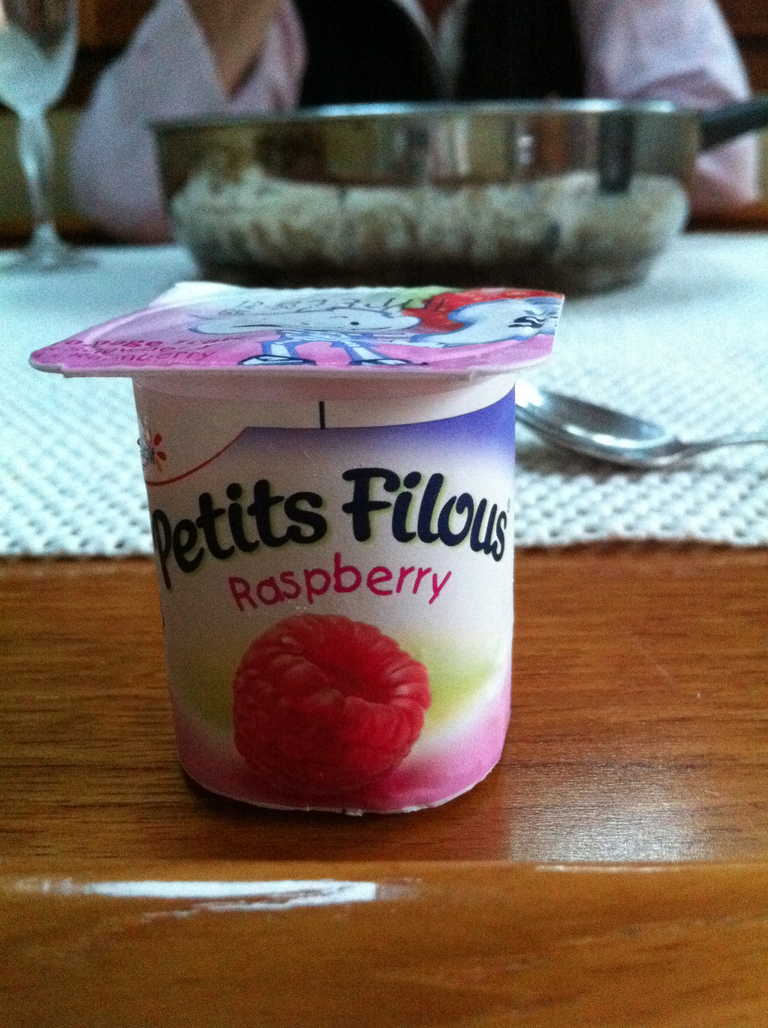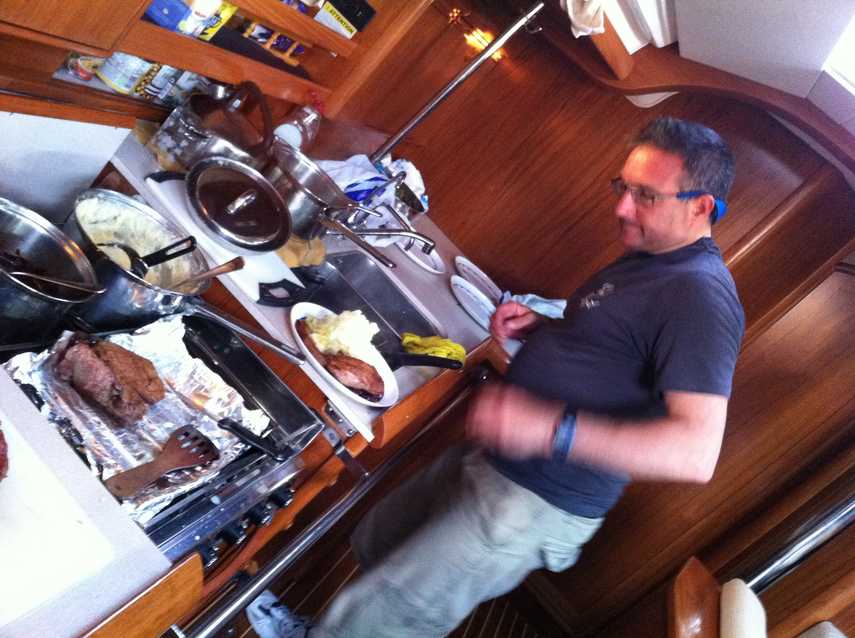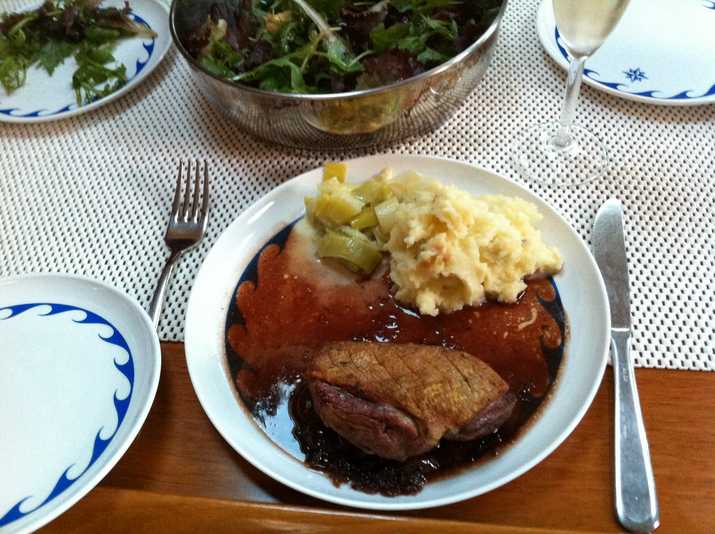
Gourmet Cooking On Boats
Away again on Erin, we are doing a couple of feeder races to take the boat down to Blyth for
East Coast Sailing Week,
and there's only the four of us this time with a guaranteed overnight stop in the safety and comfort of Eyemouth harbour
so I've carefully planned a gourmet meal within the strict constraints of
Erin's onboard cooking rules.
I was going to include a Lime Thyme Risotto, but decided that was a bit too much trouble and risked violating rule 1, so went with the safer mashed potato option.
In the end no one had room for a baked dessert and only managed to squeeze in tiny petits filous instead.
I shall leave you to guess where I hid the bacon.
I was going to include a Lime Thyme Risotto, but decided that was a bit too much trouble and risked violating rule 1, so went with the safer mashed potato option.
In the end no one had room for a baked dessert and only managed to squeeze in tiny petits filous instead.
I shall leave you to guess where I hid the bacon.
menu
Main Course
Duck Breasts in a Cherry Sauce
Buttered Leeks
Lime Thyme Mashed Potato
Side Salad
Dessert
Baked Bananas with Rum and Lime
For a lightweight finish :)
Duck Breasts in a Cherry Sauce
Buttered Leeks
Lime Thyme Mashed Potato
Side Salad
A rocket salad dressed with a balsamic vinaigrette
Dessert
Baked Bananas with Rum and Lime
For a lightweight finish :)
Duck Breasts in Cherry Sauce
main fowl nautical
Pan-fried duck breasts in a cherry and port sauce
It seems that every chef has a different preferred way of cooking duck breasts,
from roasting them skin-side down all the way in the oven,
through frying them skin-side down only and finishing them off in the oven,
to flipping them frantically from skin to flesh side à la Heston Blumenthal.
Some slap into a hot pan, some cook slowly from cold. Some don't seem to think a bout in the oven is necessary at all.
I guess you pays your money, you takes your choice.
Personally I find it hard to get duck breasts' done-ness just right.
They usually seem to be too thick to cook through properly in the frying pan without drying them out too much, so finishing off will probably be required.
You can either do this in the oven as I do, or you can simmer the breasts in the sauce you are about to make.
The best bet for getting your ducks perfectly cooked for all concerned is to use a meat thermometer. For wild breasts (not those intensive salmonella-farmed ducks) and bearing in mind that the temperature will carry on rising a little after you remove the meat from the heat:
Whichever method you choose, be sure to leave the breasts for a few minutes rest and relaxation between cooking and serving.
Some slap into a hot pan, some cook slowly from cold. Some don't seem to think a bout in the oven is necessary at all.
I guess you pays your money, you takes your choice.
Personally I find it hard to get duck breasts' done-ness just right.
They usually seem to be too thick to cook through properly in the frying pan without drying them out too much, so finishing off will probably be required.
You can either do this in the oven as I do, or you can simmer the breasts in the sauce you are about to make.
The best bet for getting your ducks perfectly cooked for all concerned is to use a meat thermometer. For wild breasts (not those intensive salmonella-farmed ducks) and bearing in mind that the temperature will carry on rising a little after you remove the meat from the heat:
- 120-130°F/49-54°C for rare
- remove at 122°F/50°C for Karl, letting the final internal temperature rise to 125°F/52°C
- 135-145°F/57-63°C for medium
- more than 155°F/68°C for well done
Whichever method you choose, be sure to leave the breasts for a few minutes rest and relaxation between cooking and serving.
Serves 4
Ingredients
- 4 duck breasts
- 200g cherries, stoned, halved or 50g dried cherries
- 400ml chicken stock
- 1 cup/300ml port
- 1 glass berry-flavoured Genever
- pinch thyme
- 20g cold butter, cut into cubes
- minced onion/shallot/garlic optional
Preheat the oven to 200°C/400°F/Gas 6.
Cut the cherries in half, discarding their stones or put your dried cherries to soak in port or red wine if you fancy that.
Put the chicken stock in a small saucepan and reduce it to about a third so that it starts to thicken up slightly.
Throw in a few strands of stripped thyme leaves, and the cherry halves and set to one side.
Score diamond-pattern slashes into the skin of the duck breasts with a sharp knife, without cutting down to the flesh.
Rub the breasts all over with salt and pepper.
Place the breasts skin-side down in a cold heavy frying pan or skillet over a medium heat.
Drain off some of the oil and save for roasting potatoes, then turn the breasts and cook for a further 4-5 minutes until lightly browned and the flesh feels springy.
Meanwhile finish the sauce -
Lightly fry the shallots if you are using them in the duck pan until colouring, then deglaze the pan with the Genever and the port, simmer 5 minutes until the alcohol is reduced and beginning to thicken, then add the stock and cherries and simmer for another 5 minutes until nicely thickened. Add back any juices that have drained out of the duck while it was roasting and resting. Whisk in a few lumps of cold butter to make the sauce glossy.
Slice the duck diagonally (if you can be bothered) and serve over a drool of the sauce.
Cut the cherries in half, discarding their stones or put your dried cherries to soak in port or red wine if you fancy that.
Put the chicken stock in a small saucepan and reduce it to about a third so that it starts to thicken up slightly.
Throw in a few strands of stripped thyme leaves, and the cherry halves and set to one side.
Score diamond-pattern slashes into the skin of the duck breasts with a sharp knife, without cutting down to the flesh.
Rub the breasts all over with salt and pepper.
Place the breasts skin-side down in a cold heavy frying pan or skillet over a medium heat.
Drain off some of the oil and save for roasting potatoes, then turn the breasts and cook for a further 4-5 minutes until lightly browned and the flesh feels springy.
At this point the duck is probably still rather too rare for most tastes, (especially the skipper's if you're cooking this on a boat).
So you will have to continue cooking until all signs of pinkness have gone sigh.
Put the breasts skin-side up uncovered in the oven for 5-8 minutes or until they are cooked to your satisfaction,
then set aside covered in foil to rest for 2-4 minutes before serving them.Meanwhile finish the sauce -
Lightly fry the shallots if you are using them in the duck pan until colouring, then deglaze the pan with the Genever and the port, simmer 5 minutes until the alcohol is reduced and beginning to thicken, then add the stock and cherries and simmer for another 5 minutes until nicely thickened. Add back any juices that have drained out of the duck while it was roasting and resting. Whisk in a few lumps of cold butter to make the sauce glossy.
Slice the duck diagonally (if you can be bothered) and serve over a drool of the sauce.
This was absolutely delicious, though my sauce was slightly too thin
(it didn't seem to want to go any thicker - possibly because I was using ready-made stock),
and the duck was overcooked for my taste (though probably not the skippers!).
I think you might consider adding a little cherry jam or conserve to get the sauce that bit thicker, or try reducing the stock harder before adding the cherries (you don't want the cherries actually disintegrating).
I think you might consider adding a little cherry jam or conserve to get the sauce that bit thicker, or try reducing the stock harder before adding the cherries (you don't want the cherries actually disintegrating).
Buttered Leeks
side veg nautical
Simple but delicious leeks.
A simple, traditional, and delightful way to cook leeks. You could also use it for cabbage with a little extra stock.
Serves 4
Ingredients
- 2 leeks
- a 30g/1oz wedge of butter
- thyme optional
- salt and white pepper
- cream optional
Cut away the root, dried-up outer leaves and anything too green from the leeks.
Slice into fat rounds about 1" or so wide.
Wash the leeks thoroughly, drain, and put in a pan with a healthy knob of butter, a generous sprinkling of thyme leaves and season enthusiastically with salt and white pepper.
Stir the butter through and cook, covered, over a low heat for 10-15 minutes until meltingly soft.
You can cook them uncovered towards the end if they're looking a bit soggy, and you can stir through a little cream before serving for an extra rich version.
Slice into fat rounds about 1" or so wide.
Wash the leeks thoroughly, drain, and put in a pan with a healthy knob of butter, a generous sprinkling of thyme leaves and season enthusiastically with salt and white pepper.
Stir the butter through and cook, covered, over a low heat for 10-15 minutes until meltingly soft.
You can cook them uncovered towards the end if they're looking a bit soggy, and you can stir through a little cream before serving for an extra rich version.
So easy. So tasty!
Baked Bananas with Rum and Lime
dessert veg nautical
Bananas baked with sugar, rum and lime.
Serves 4Ingredients
- 6 firm bananas
- zest of 1 lime
- juice of 2 limes
- 3 tablespoons dark-brown muscovado sugar
- 50ml/2 fl oz rum
To Serve:- juice of ½ lime
- 2 tablespoons rum
- ice cream or whipped cream
Peel the bananas and halve lengthways.
Sprinkle the lime zest, half the juice and half the sugar into a shallow baking-dish.
Lay the bananas on top in a single layer.
Pour on the rest of the lime juice and all of the rum, and add the remaining sugar.
Put in an oven preheated to 220°C/425°F/gas mark 7 and bake for 15 to 20 minutes or until the bananas are soft.
Stick the dish under a hot grill until bubbling — about three minutes.
Drizzle on more lime juice and rum and serve immediately with ice cream or whipped cream.
Sprinkle the lime zest, half the juice and half the sugar into a shallow baking-dish.
Lay the bananas on top in a single layer.
Pour on the rest of the lime juice and all of the rum, and add the remaining sugar.
Put in an oven preheated to 220°C/425°F/gas mark 7 and bake for 15 to 20 minutes or until the bananas are soft.
Stick the dish under a hot grill until bubbling — about three minutes.
Drizzle on more lime juice and rum and serve immediately with ice cream or whipped cream.
I didn't actually try this, since everyone was too stuffed with duck breasts and cherry sauce,
but it looks like a convenient alternative to Erin's more usual
Flaming Rum Bananas.



I've also seen it suggested that you do this on a very low heat for 20-30 minutes, occasionally draining off excess fat, before turning the heat up high to crisp the skin, then flipping the breasts to cook the other side.
It's possible this method will cook the breasts well enough all the way through that they won't need more cooking in the oven before resting and serving.
But you'd have to check.